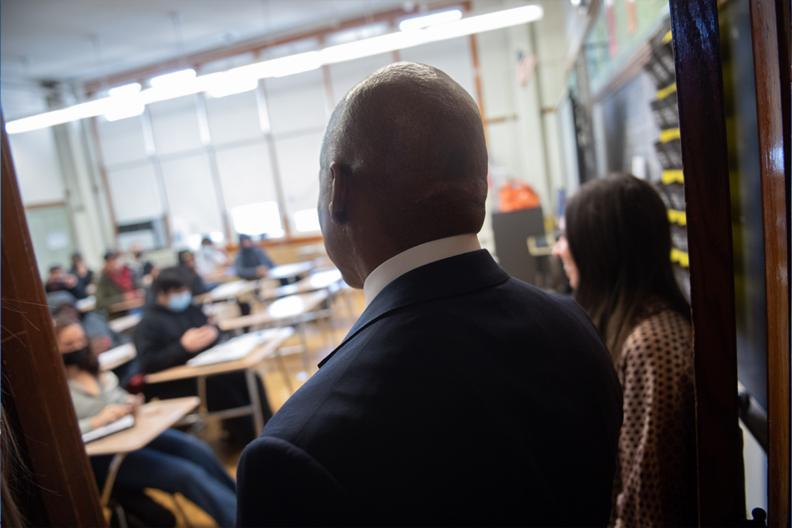How a Fake Budget Crisis was Used to Gut Funding for NYC Schools
The City has the money to fully-fund schools. So why is it trying to gut them?

It has been a summer of uncertainty and false scarcity for New York City’s schools. Due to a $300 million budget cut to the City’s public schools, teachers, social workers, and other beloved school employees were told not to come back to work next year.
The City isn’t broke, and the State is sending New York City its portion of education funding without cuts, so why does Mayor Adams’ first budget slash classroom spending?
The sweeping cuts – estimated to top $300 million across 1,200 schools – demonstrate plainly the dangers of giving near total control over education to a mayor who does not value education.
In his budget, Adams found enough cash to increase police spending but not enough to help schools retain student support, arts, and music programs. Funding that supports students’ futures and educators’ livelihoods shouldn’t be cut — especially not now, as our city emerges from the trauma of the pandemic.
Data analyzed by Chalkbeat shows cuts could meet or exceed $5 million at a single school – Brooklyn’s Fort Hamilton High School. Chloe Liang, a rising senior at Fort Hamilton High School and a youth organizer in the NYCLU’s Teen Activist Project (TAP), has spent her summer vacation coming to terms with the direct impacts these cuts will have on her education.
“After hearing about the potential $5 million funding cut to my school – and much more to thousands of public schools in the City — I felt enraged and disappointed,” Chloe told us. “I have seen firsthand how funding affects my student life and school environment. It just shows how little the City Council Members and Mayor Adams care about our schools and the well-being of students.”
Since the City Council voted to adopt Mayor Adams’ budget in June, outraged New Yorkers have taken to the streets — and the courts — in vehement protest. Advocates are not only calling for school funding to be restored, but are asking the court to stop the City from shortchanging public participation in education.
Mayor Adams must not be allowed to manufacture a fake budget crisis in order to shortchange our students.
Last month, parents and teachers filed a lawsuit against the Department of Education for cutting the public out of the budget approval process. The NYCLU has filed an amicus brief in support of the suit.
Instead of holding a 45-day public comment period prior to the budget vote, which the law requires, the public comments regarding the annual estimated budget were crammed into four hours during the City school board’s June meeting. (The New York City school board is known colloquially as the Panel for Educational Policy or PEP). This meeting took place after the budget was already passed by the Council.
One educator who spoke at the meeting identified the cuts as part of a “continued and ongoing campaign to divest in public education,” and reminded the PEP of its role to “fight for a sound and basic education” for all of New York’s students.
After hearing from their constituents, several City Council members, including Council Speaker Adrienne Adams, admitted they voted for the budget without fully understanding the impact of the cuts. But this is precisely the type of information that principals, and even the New York City Comptroller, could have provided during a proper public comment period. As the lawsuit argues, the rushed process of approving the education budget “deprived the City Council of the benefit of the public hearing, public comments, and vote by the PEP.”
Public comment is a vital part of a functioning democracy because it gives lawmakers more information about how their actions reverberate in people’s real lives. A healthy democracy doesn’t necessarily work quickly — instead, it makes space for deliberation and participation by impacted parties. In future budget years, the Mayor and Chancellor must make space for public comment on the budget.
On August 22, New York City Comptroller Brad Lander endorsed a resolution that would immediately reverse the “unnecessary and harmful” cuts during his testimony to the City Council’s Committee on Education. Using a modest portion of unspent stimulus funding to equitably support schools is both the fiscally responsible – and morally sound – decision the City should make on behalf of its students.
Even if funding is restored by the courts, this episode leaves a lasting mark on Mayor Adams’ first term. Parents, educators, and students are left to grapple with mayoral control of schools in the hands of a mayor whose budget choices have prioritized incarceration over education.
If the inequities and uncertainties that defined Mayor Adams’ first budget are any indication, we can be certain more attempts to gut school budgets will come. City Council members must be prepared to resist any such budgets in the future, and the state legislature should make it harder for the mayor to cut out the voices of his constituents.
Mayor Adams must not be allowed to manufacture a fake budget crisis in order to shortchange our students.
